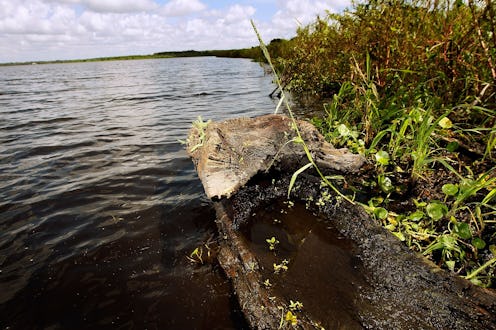News
Irma Unearthed A Potentially Historic Artifact From The Depths Of A Florida River

Hurricanes are generally known for making history — not for uncovering it. And while Hurricane Irma certainly made history knocking out millions of customers' electricity, tearing down trees, and flooding streets, it may have also unearthed a bit of history too. In the aftermath of Hurricane Irma, a dugout canoe was found in Florida and an initial assessment of the washed up vessel reveals it could be up to several hundred years old.
Randy "Shots" Lathrop reported finding the historical boat along the banks of the Indian River during a Sept. 11 bike ride around the north side of Cocoa, Florida. Lathrop told NBC he'd been biking around to survey the extent of Irma's damage when he spotted the canoe. "I didn't believe it," Lathrop told NBC News. "I was shocked. I was happy because it made perfect sense to me that it would end up here. Any time we have any kind of storm, certain parts of our coastline are just swarming with [people with] metal detectors because they understand that items wash ashore after hurricanes."
According to Florida's Division of Historical Resources, Lathrop was familiar with state laws, which require the Division of Historical Resources to be notified about potential archaeological and historical finds, and immediately reported the canoe. To protect the canoe until it could be assessed, Lathrop had a friend help him move the canoe, which NBC reported weighed nearly 700 pounds and was roughly 15 feet long, to a safer location.
Excited by his find, Lathrop shared some pictures of the canoe on Facebook "Look what Irma kicked up out of the bottom of the Indian River, a dugout canoe," Lathrop wrote in the caption. "Florida State Dept of Historical Resources has been notified, they are sending an archeologist in the morning."
In its own Facebook post about the canoe, Florida's Division of Historical Resources described the boat as "waterlogged" with "a very small number of barnacles on it." They revealed an initial assessment had been completed Thursday by a local archeologist. "The construction [of the canoe] is atypical, with not only a squared off form commonly seen in the historic period, but compartments and what appears to be a seat," the Division of Historical Resources wrote. A spokesperson for the Division of Historical Resources told ABC News that the presence of nails in the canoe helped researchers narrow down the boat's potential age as cut nails first came into production in the early 19th century.
But while an initial assessment suggested the canoe was at least over 50 years old, it may be a few weeks before the Division of Historical Resources can confirm a more exact age. The department is currently having the canoe carbon dated. "Overall, its appearance and the presence of a cut nail suggests it is not a pre-contact canoe," the department wrote on Facebook. "In other words, it is maximum several hundred years old and minimum probably several decades old."
But Irma isn't the only storm to wash a mystery ashore. A bizarre sea creature was found decaying on a beach in Texas City, Texas after Hurricane Harvey pummeled the state's Gulf Coast with violent winds, heavy rain, and life-threatening storm surge. Pictures of the mysterious creature were first posted to Twitter by Preeti Desai, the National Audubon Society's social media manager, along with a simple quarry: "What the heck is this??"
Ultimately, several experts concluded the creature was most likely a member of the Ophichthidae family, known more commonly as snake eels. More specifically, Smithsonian National Museum of Natural History biologist Dr. Kenneth Tighe, who is also an eel specialist, told Earth Touch News he believed the creature was an Aplatophis chauliodus, also known as fangtooth snake eel or "tusky" eel.
If the canoe is determined to be historic it will be stabilized and preserved by Florida's Division of Historic Resources, with the ultimate goal of putting it on display somewhere local. "The Division of Historical Resources is working with local museums to provide a short-term and long term plan for its conservation, preservation, and ultimate public display in Cocoa," the department said in a statement on Facebook.